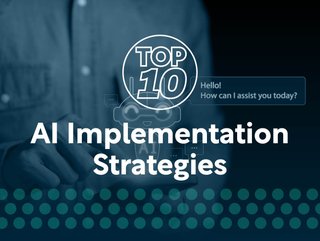
Whilst businesses are keen to invest in AI, many are often unsure how to.
The technology is working to revolutionise business operations by enabling them to automate tasks, create new products and services and elevate customer experiences.
However, generative AI (Gen AI) investments continue to surge, early adoption could result in challenges such as fears over privacy, security, AI regulation and internal skills gaps. Creating a clear and robust AI strategy is necessary for organisations to deliver real innovation, which will result in continued growth.
AI Magazine considers some of the leading ways in which businesses can best implement and harness AI technology in order to stay ahead in a rapidly-changing industry.
10: Stay Informed About AI Trends and Regulations
The AI field is rapidly evolving and staying informed about the latest technologies, use cases and regulations will help organisations maintain a competitive edge in a rapidly evolving digital landscape.
By keeping up to date, businesses can discover new ways to use AI to improve their products, services and operations. This could involve automating simple tasks to free up their human workforces, or personalising customer experiences.
9: Experiment with Pilot Projects
By testing AI technology, businesses can understand its strengths and limitations and how to use it responsibly and ethically. As this is a type of technology that is constantly changing, companies will benefit from remaining flexible as they seek to confront new opportunities and challenges.
It is advisable for companies to start with pilot projects in order to test how AI solutions work within their environment. As a result, the company can learn and adapt strategies in a risk-free space and better build internal support.
8: Monitor and Evaluate AI Systems Continuously
Regularly reviewing how AI systems are performing is necessary to ensure they are delivering what is expected of them. Likewise, monitoring also helps to identify any issues or biases in the AI models so that these can be evaluated and the systems can be improved.
Without proper oversight from businesses, unintended consequences could emerge. These could include a lack of accuracy or result in genuine enterprise threats. AI systems that are not monitored or upgraded could lead to mass security breaches for a business.
7: Foster Collaboration Between AI and Human Workers
It can strongly benefit a business if humans and AI work in tandem to achieve business outcomes. By collaborating, a company can achieve tasks and goals that would not have otherwise been accomplished - or it would have taken much longer to succeed.
AI and humans working together can also lead to increased business efficiency, improved decision-making and freeing up human employees for more complex tasks.
With well-designed workflows that are able to allow humans and AI systems to collaborate based on each other’s strengths, a company can enhance productivity and innovation.
6: Upskill and Reskill Employees
With continued anxieties over AI replacing human jobs, it is important for businesses to continue prioritising the capabilities of its employees via upskilling and reskilling initiatives.
Companies can prepare the workforce for greater AI integration by providing training and development opportunities. As a result, workers can better transition to new roles that AI technologies may create and reduce scepticism over the technology.
Microsoft and SAP are just some of the leading companies that have commenced training programmes to expand interest and knowledge of AI systems.
5: Adopt Ethical AI Principles
Ethical AI is becoming increasingly more important for a business harnessing the technology. This is necessary in order to avoid bias, maintain customer trust and avoid errors within datasets. It is becoming more important for businesses around the world to be transparent about their AI strategies, with countries such as the US implementing mandatory regulations.
It is advisable for businesses to develop and stick to its ethical AI guidelines. Some key points for consideration are fairness, transparency, accountability and privacy, which may help to mitigate risk and build trust among a company’s stakeholders.
4: Secure Executive Buy-In and Support
Executive buy-in refers to an agreement from a company’s executives and leadership to support or invest in a project. Ultimately, it is favourable that enterprise AI initiatives should have the endorsement of senior management in order to secure funding for crucial resources to develop the technology safely and effectively.
As a result, a company can successfully foster a culture that embraces change and technological advancement. It means that senior leadership understands the importance of managing risk when it comes to AI, in addition to driving organisation-wide adherence.
3: Prioritise Data Quality and Governance
Data governance is beneficial for enterprise AI as it covers the full data lifecycle and helps to enable more responsible systems.
Investing in strong data quality and establishing strong data governance practices will help businesses to train AI models that are accurate and relevant to today’s business landscape. Quality is also important to help the AI model to generate better results. If the quality of data used to train an AI model is biassed or incomplete, then its results will be also.
2: Invest in Data Infrastructure
AI systems rely heavily on data. Therefore, ensuring that businesses have robust data infrastructure that can collect, store, and process large volumes of data securely and efficiently, is necessary.
Generative AI (Gen AI) in particular requires good data and so companies harnessing this technology need to invest in this to train their AI models successfully.
Investment ultimately leads to greater business outcomes and a workforce that can fully realise the positive impact that AI and machine learning can offer an organisation - both internally and for its clients and customers.
1: Define Clear Objectives
Arguably the most important, organisations must have a clear idea of what they want to do with AI. If they don’t, it could result in monetary losses and maybe even catastrophic results for business operations.
According to IBM, a successful AI strategy will provide a roadmap for addressing challenges, building necessary capabilities and ensuring strategic and responsible application of AI.
Establishing specific and measurable objectives for what the business is aiming to achieve with AI will result in greater efficiency, cost reductions, enhanced customer experience and continued innovation in such a rapidly-changing and turbulent industry.
******
Make sure you check out the latest edition of AI Magazine and also sign up to our global conference series - Tech & AI LIVE 2024
******
AI Magazine is a BizClik brand
- Pope set to Attend G7 Summit and Highlight AI ChallengesAI Strategy
- Parexel and Palantir: Powering Positive Healthcare OutcomesAI Applications
- Sundar Pichai: Google Seeks to Expand its AI OpportunitiesAI Strategy
- Mistral AI Continues to Push Forward Competitive European AIMachine Learning






